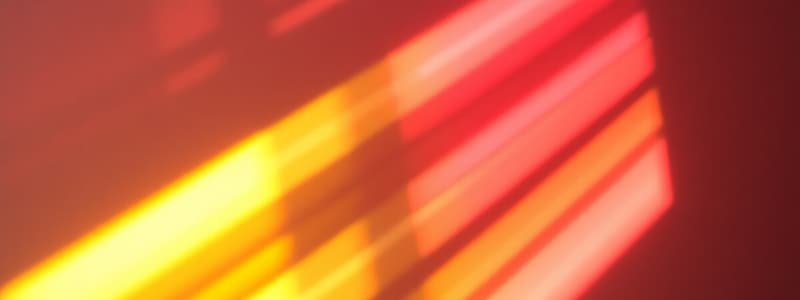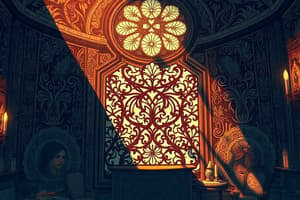Podcast
Questions and Answers
What happens to the size of a shadow as an object moves closer to a light source?
What happens to the size of a shadow as an object moves closer to a light source?
- The shadow becomes smaller.
- The shadow becomes larger. (correct)
- The shadow disappears completely.
- The size of the shadow remains the same.
Which statement correctly defines the law of reflection?
Which statement correctly defines the law of reflection?
- The angle of incidence is equal to the angle of reflection. (correct)
- The angle of incidence is always less than the angle of reflection.
- The angle of incidence is always greater than the angle of reflection.
- The angle of incidence is irrelevant to the angle of reflection.
What type of surface reflects light in a more organized manner, resulting in clearer images?
What type of surface reflects light in a more organized manner, resulting in clearer images?
- Translucent surfaces
- Smooth surfaces (correct)
- Opaque surfaces
- Rough surfaces
How does color affect the reflection of light?
How does color affect the reflection of light?
What is it called when light is scattered in many directions after hitting a rough surface?
What is it called when light is scattered in many directions after hitting a rough surface?
What type of mirror produces an upright image that is the same size as the object but reversed?
What type of mirror produces an upright image that is the same size as the object but reversed?
What effect does the distance of an object from the light source have on the shape of the shadow?
What effect does the distance of an object from the light source have on the shape of the shadow?
What is the phenomenon called when mirrors are used for viewing objects around corners?
What is the phenomenon called when mirrors are used for viewing objects around corners?
Flashcards
Rectilinear propagation
Rectilinear propagation
Light travels in straight lines.
Transparent
Transparent
Objects that allow light to pass through them completely.
Opaque
Opaque
Objects that block all light from passing through.
Translucent
Translucent
Signup and view all the flashcards
Shadow formation
Shadow formation
Signup and view all the flashcards
Reflection
Reflection
Signup and view all the flashcards
Law of reflection
Law of reflection
Signup and view all the flashcards
Specular reflection
Specular reflection
Signup and view all the flashcards
Study Notes
Light Shadows and Reflections
- Light travels in straight lines. This is called rectilinear propagation.
- Objects that allow light to pass through them are transparent.
- Objects that do not allow light to pass through are opaque.
- Objects that allow some light to pass through are translucent.
- Shadows are formed when an opaque object blocks the path of light.
- The size and shape of a shadow depend on the size and shape of the object and the distance of the object from the light source.
- The closer an object is to the light source, the larger the shadow.
- The farther an object is from the light source, the smaller the shadow.
- The shape of the shadow is the same as the shape of the object.
- The position and size of the shadow change depending on the position of the light source relative to the object.
- Light striking an object can be reflected.
- Reflection is the bouncing of light off a surface.
- The angle of incidence (the angle at which light hits a surface) is equal to the angle of reflection (the angle at which light bounces off the surface). This is known as the law of reflection.
- Smooth surfaces reflect light in a more organized way than rough surfaces. This results in a clearer image.
- Rough surfaces scatter light in many directions, which is why light doesn't reflect back in a clear image. This phenomenon is called diffuse reflection.
- Mirrors are smooth surfaces that reflect light in a way that produces clear images.
- Different types of mirrors reflect light differently.
- Plane mirrors create upright images that are the same size as the object, but reversed.
- A periscope uses mirrors to reflect light and allow for viewing objects in difficult to see locations, like around corners.
- Examples of reflection in everyday life include seeing your reflection in a mirror, seeing light reflected off a pool of water, or seeing a rainbow.
- When light reflects off a smooth surface, the reflected rays travel in a predictable way.
- Reflection is important in many technologies, such as telescopes and microscopes.
- The amount of light reflected also depends on the colour of the object.
- Darker colors absorb more light and reflect less.
- Lighter colors absorb less light and reflect more.
Studying That Suits You
Use AI to generate personalized quizzes and flashcards to suit your learning preferences.




